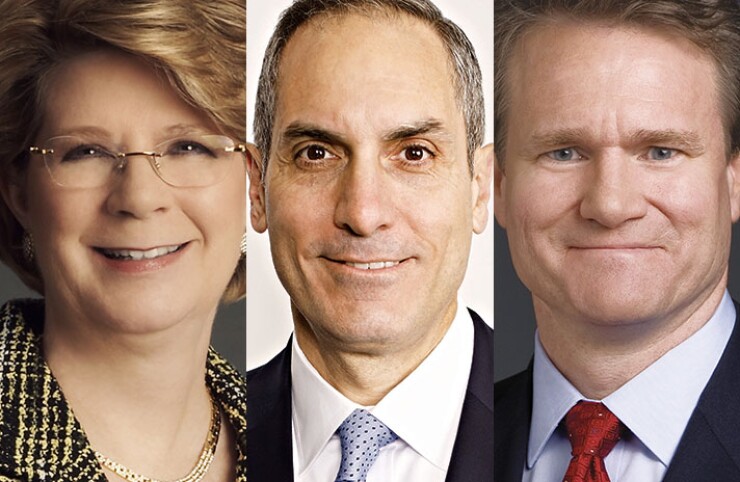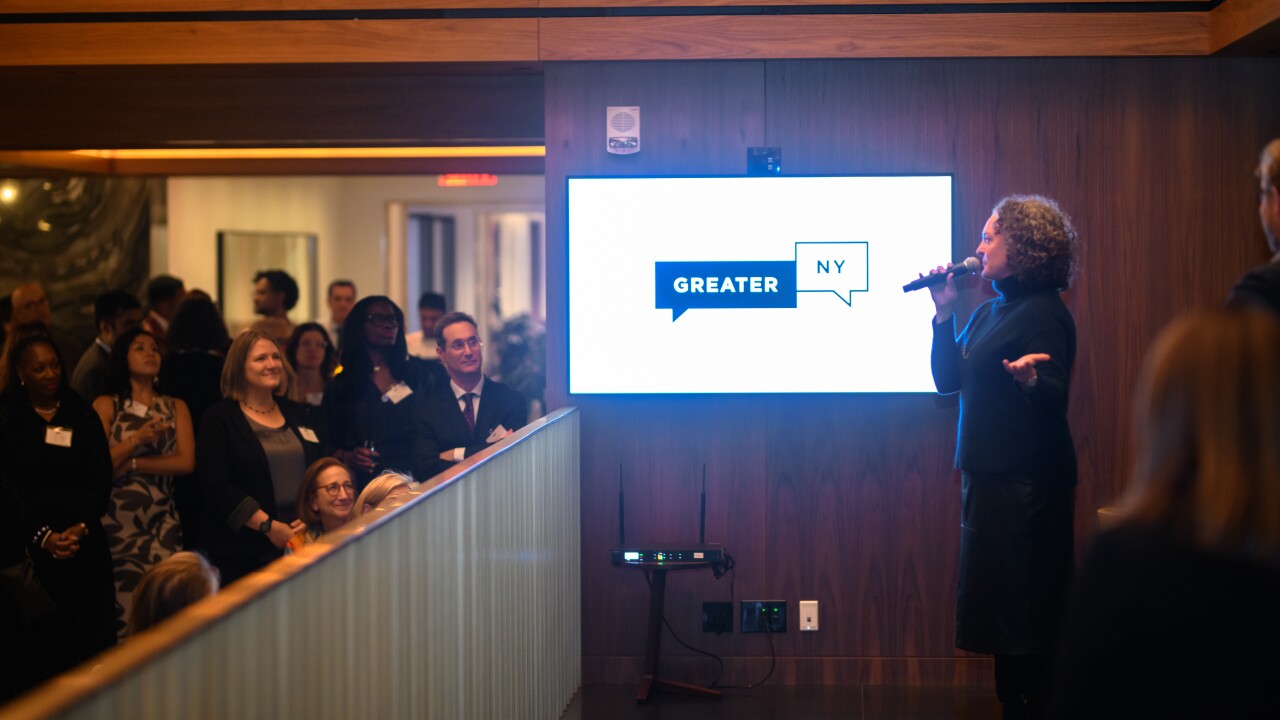Executives at some of the largest banks are sounding upbeat about the direction of the industry on the cusp of the new year despite widespread fears of recession and lingering trade issues with China.
Their optimism — ubiquitously spread throughout presentations at a Goldman Sachs financial services conference Tuesday in New York — contradicted the punishment investors have inflicted on bank stocks this year, as the Keefe, Bruyette & Woods Bank Index has dropped 9.7%.
Their argument? Commercial loan pipelines are surging, these CEOs said. They have found many other ways to grow besides large, risky M&A deals. And continued investments in technology upgrades, despite their high cost, are helping drive deposit growth.

Here is a closer look at three of the areas discussed at the conference—commercial loan demand, mergers and acquisitions, and spending on technology.
Commercial loans: Said to be on rebound
The CEOs said they are optimistic that the
Business lending has been lackluster over the past few years, even as the overall economy has expanded at a strong pace. At the 25 biggest banks, for instance, commercial and industrial loans
Gross domestic product, meanwhile,
Jamie Dimon, chairman and CEO of JPMorgan Chase, said that the slowdown in middle-market lending has been very puzzling.
“Middle market is the one you can look at and say, when there’s growth in the economy, their receivables go up, their payables go down” and they need loans for capital investments, Dimon said. “That we have not really seen. Hard to figure out why.”
One likely reason for weak loan demand is that the corporate tax cut left businesses with excess cash. But the hope among lenders is that they still need credit in order to keep growing.
“I kind of expect to see more usage of revolvers in middle-market lending,” Dimon said. “I kind of still expect that to happen at this part of the cycle.”
At JPMorgan, middle-market banking loans dipped 2% during the third quarter from the prior period but increased by 2% compared with a year earlier.
As KeyCorp noted at an investor conference in October, the Cleveland bank expects commercial lending to increase faster than at its rivals, although it declined to specify its anticipated growth rate. Still, as commercial lending goes, so does the rest of the bank’s fortunes, Mooney said Tuesday.
“Our most significant lever for loan growth has been our commercial loan growth,” she said.
Andy Cecere, chairman and CEO of U.S. Bancorp, also struck a positive tone on commercial lending, saying that the Minneapolis company’s “pipelines are strong.”
U.S. Bancorp will set itself apart when the economy takes a turn for the worse, and nonbank lenders — such as private-equity firms and fintechs — that made risky loans begin to struggle, Cecere said.
“Where the kind of rubber meets the road is when you start to see the end of the cycle, and the credit risk starts to become more prominent,” Cecere said.
In the meantime, as the economy grows at a modest, albeit steady rate in the 3% range, Bank of America expects that its commercial loans will probably increase at the same pace, Chairman and CEO Brian Moynihan said.
“We feel pretty good,” he said. “It’s consistent with a 3% economy. Commercial loan growth ought to be what we’re delivering in this kind of an economy.”
M&A: Surgical strikes are preferred MO
One message came through loud and clear when bankers were asked about their appetites for mergers and acquisitions — large deals are going to be few and far between.
Instead, growth will come by entering new markets, opening branches, hiring banker teams from rivals or finding deals for niche businesses like wealth management or technology firms. Deals like KeyCorp’s October 2016 acquisition of First Niagara Bank in Buffalo, N.Y., was an outlier, Mooney said.
“Our growth strategy has really been not to try and be all things to all people, but to target scale where you can be relevant and get outsize growth against either a certain client segment or product,” she said.
SunTrust Banks in Atlanta has tried to fill strategic holes with small deals instead of huge acquisitions, Chief Financial Officer Allison Dukes said. Those have included Pillar Financial, a commercial real estate specialty lender, and the online consumer lender LightStream.
“Our M&A strategy continues to be focused on bolt-on capabilities,” Dukes said. “We’re looking at where we might have holes or gaps.”
Dukes noted that SunTrust has also actively expanded through hiring, as it has added about 800 bankers over the past 10 years.
“We don’t just have to use M&A anymore,” she said. “That’s give us an opportunity to really protect our culture [and] screen for cultural fit.”
Bank of America’s Moynihan said he has very little desire to pursue deals, as plenty of opportunity lies in the bank’s existing businesses. BofA considered, but rejected, pursuing a deal for a wealth management firm outside the U.S.
“We found a global wealth management [firm] outside of the States,” Moynihan said. “It had no scale, had no ability to scale. It had 250 financial advisers. Why would I spend time trying to figure out how to go from 250 to 300 in a country, when I can go from 400 [financial advisors] to 800 in Houston, where I have market share power?”
U.S. Bancorp has been subject to an enforcement action that has limited its ability to open branches. But once the consent order is lifted, the Minneapolis company could focus on restructuring its retail network, Cecere said.
“We have been a little bit handcuffed in terms of where we can open and/or therefore close branches,” Cecere said. “I think we have an opportunity to more optimize our structure across our footprint. But less likely in terms of a large deal.”
Large and regional banks will not be acquiring other banks, but that does not mean consolidation will be dormant, Dimon said. Many banks need to beef up their holdings of low-cost deposits, which should fuel dealmaking, he said.
“We can’t buy insured deposits anymore, so we can’t play that game,” Dimon said. “I mean, if you are a bunch of the banks, I won’t give their names, I would actually have my mind on the target to acquire someone where it makes sense.”
Technology investments are here to stay
Technology continues to remain a priority. Tech investments have
During the conference, CEOs defended the size of their tech budgets. Each of the industry’s biggest banks plan to spend around $10 billion in 2018 on everything from data centers to new innovations.
Dimon said he tells business-line leaders at JPMorgan to make sure they invest in the technology they need to stay competitive over the long run. Looking solely at the payback could lead bankers to underinvest – and lose business over time.
“We don’t tell them your budget is $1 billion and no more,” Dimon said. “We say, ‘Are you building the things you need to compete and win in the future?’”
In contrast, U.S. Bancorp,
U.S. Bancorp is focused on revamping its mobile app and improving its payments and commercial banking technology.
Asked whether U.S. Bancorp’s tech budget is big enough to keep pace with larger peers, Cecere said that what’s most important is the quality of the investments, rather the quantity.
“I have to tell you, it’s easy from a digital and technology and innovation standpoint to spend a lot of money if you choose to, and sometimes you’re spending that money against initiatives that don’t come out in terms of successful outcomes,” Cecere said.
Finally, technology investments have helped drive a top priority of virtually all banks—the acceleration of deposit-gathering to provide fuel for loan growth. SunTrust, for example, has earmarked spending for its mobile banking, Dukes said. That has paid off, she said.
“Our strategy has been and continues to be a mobile-first approach. We’ve been highly focused on adding new capabilities to our mobile apps,” Dukes said. “This strategy has yielded positive results already, evidenced by the strong growth rates we’ve seen in mobile finance and mobile deposits.”





